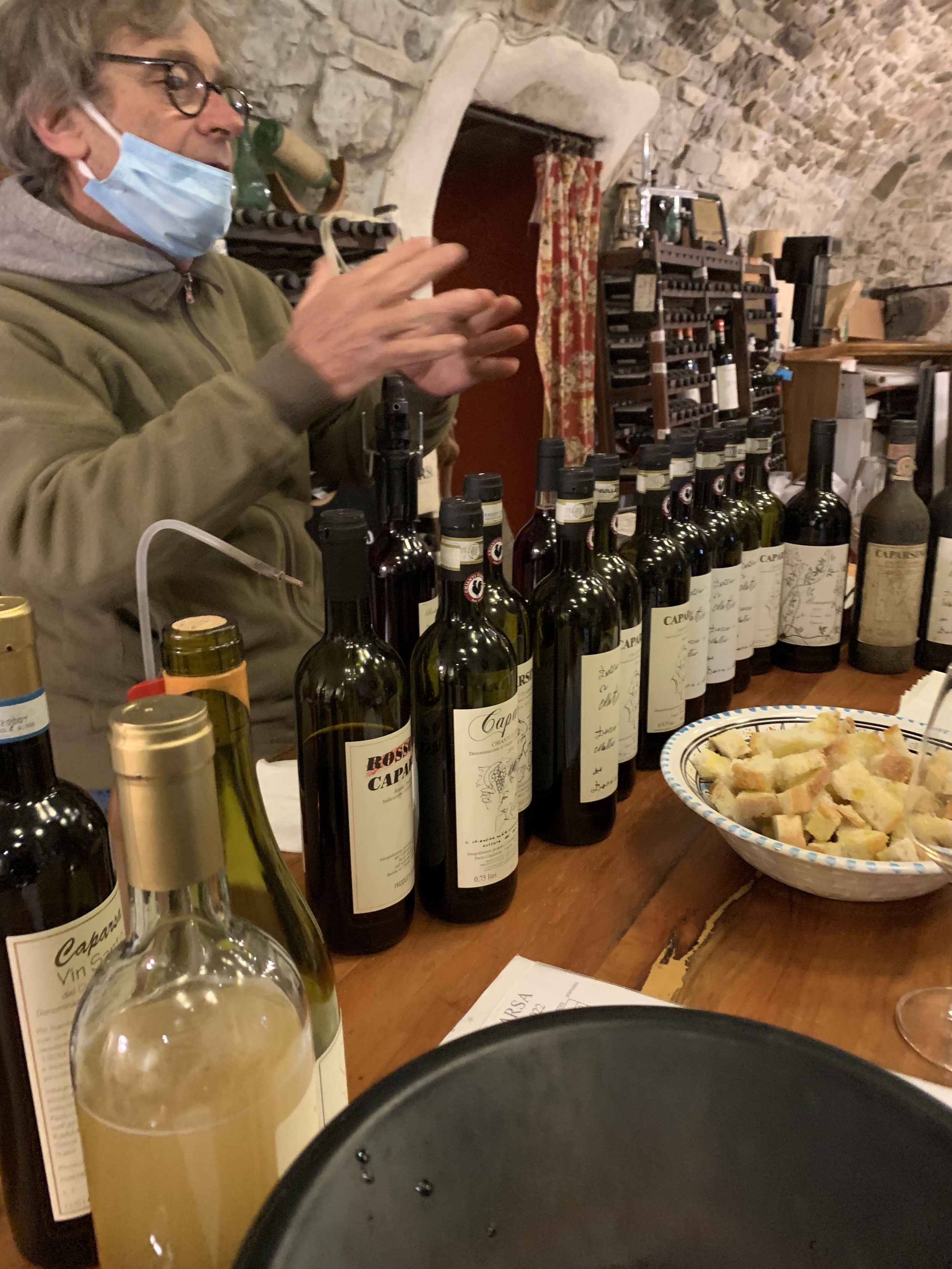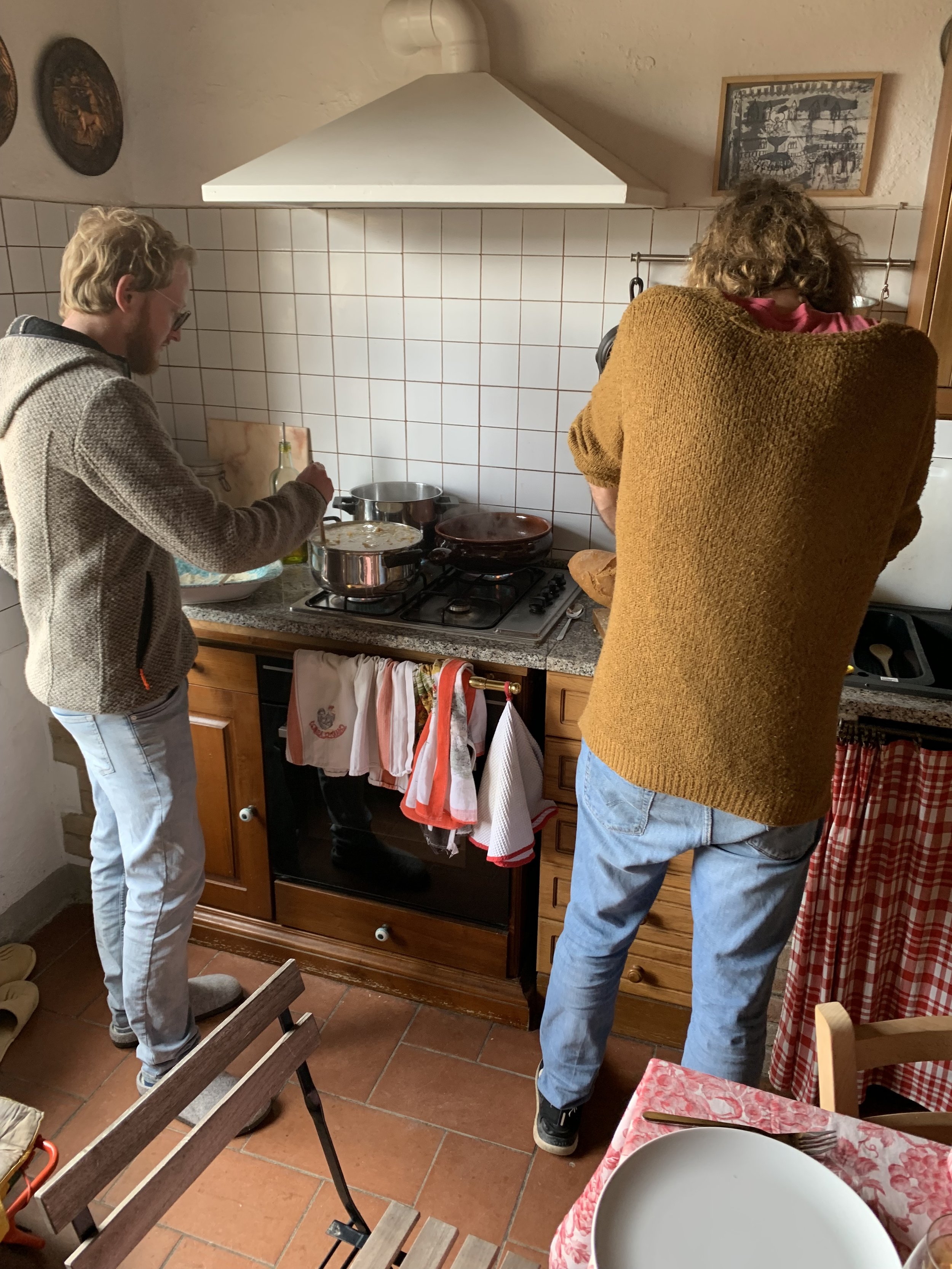Vines have soul: a day at Caparsa
A day at Caparsa with Paolo
Paolo Cianferoni seems happy to see me. Before my car door is even closed we are off on a whirlwind tour of the cellar, ending with a formidable line-up of his wines, new and antique. Paolo is always generous with bottles, but I may be benefitting from the recent visit of a prominent American wine journalist. Whatever the reason, I’m happy to taste through verticals of Caparsino and Doccio a Matteo, wines that, as they age, and as I grow familiar with their evolutions, allow me to learn a little about Radda terroir and vintage. The wines are so direct.
We start with the fresh stuff. 2020 Rosato di Caparsa IGT is as dark as they come. Maybe there’s an edge of rosato to the the burgundy color. A faint vivid glow. The fruit of this wine is compelling, forest berries, exuberant. I like it so much that when we sold out in autumn, I started buying bottles back from local retailers, to drink at home!
The current release of Rosso di Caparsa IGT is very fruity. Pristine Sangiovese. I bought a fiasco of this wine, to drink in Umbria. One day I’ll import it in straw baskets. In either format, it’s inspirational stuff. The IGT wines of Caparsa seriously over-deliver.
The 2018 Chianti Classico is aged mainly in cement. It has beautiful aromas. Really nice, uplifting, pure red fruit. On the palate it’s delicate, light, with a fine tannic edge to the finish. The wine is a real triumph in the classic style for Chianti. It speaks to my personal preferences in Sangiovese. I’ll drink this, and leave hotter vintages to collect dust.
2015 Caparsino Chianti Classico Riserva MAGNUMS are making an encore appearance in North Carolina. This is yet another item where you, dear consumer, will be racing me to purchase scant inventory. Not sure who I want to win!
1999 vin santo is a mix of intense glacéed orange rind and toasty Madeira. So thrilled and honored that Paolo shares this with us. Now’s a happy (if brief) time when bottles are around. Grab one to top off your next Tuscan feast, with or without biscotti.
“Wine is a mirror of life.” The life of a vine at Caparsa is hard. In the Chianti Classico DOCG, seven tons per hectare is the maximum permissible yield. Paolo’s vines yield five.
“Quality means organic. It’s the only chance. Hope for the next generation.” Paolo explains that in the vineyard there are many thousands of microorganisms. The work of the farmer is to grow this community. “Under the soil, there is a communication. A mycorrhizal network. Vines have soul. Soul is important to this kind of wine.”
“Herbicides are poison that kill not only plants, but the habitat for insects.” Paolo explains that they destroy any chance of biodiversity in a community.
“Alcohol is poison. But resveratrol is heart-healthy. Quercetin is healthy. My father and grandfather drank one and a half liters of wine per day, and lived into their 90’s.” Wow. Other factors may have been in play. Rural Tuscany is a decent landscape for healthy living. You’ll get your steps in!
Paolo’s father Reginaldo Cianferoni bought Caparsa in 1965. It was fully abandoned after World War II. All the former farmers moved to industrializing cities, to find steady paychecks. This is the reason why sixty percent of Chianti Classico today is under foreign ownership.
“The British arrived in the 1960’s. They called it Chianti-shire. The Americans arrived after 1998.
Reginaldo Cianferoni also worked at the university in Florence, and wrote a book about the daily life of people in Chianti. The story is told through the narrative device of a group of locals gathered at a simple restaurant, telling stories after dinner. Illustrations from that book adorn Caparsa’s labels.
Paolo was seven when his father bought the farm. He started working on the tractor right away. He reckons he’s worked 55 vintages at Caparsa. It’s not surprising that recent wines have gone from very good to brilliant.
Also tasted:
2019 Bianco di Caparsino smells of lemon rind and candle wax. It’s made from Trebbiano and Malvasia. It would be perfect with a Carbonara. Maybe we’ll get some bottles for autumn. Paolo didn’t make a 2020 bianco, because the vintage was too hot to make a balanced white.
Paolo’s second-oldest son Filippo made a natural wine from Trebbiano and Malvasia. It’s an orange wine aged in amphora, and it’s all sold out: destination California. Paolo is kind enough to let us try the wine anyway.
The 2018 Caparsino Chianti Classico Riserva is beautiful. Violet, blackberry, and cassis. It is aged in 1,800-liter barrels. Mid-weight, and in the classic, moderate Chianti Classico style.
Paolo thinks the 2018 Doccio a Matteo Chianti Classico Riserva is one of the best wines he’s ever made. The structure, the complexity, the many, many layers of blackness: I see what Paolo means. Today the wine is quite tannic. I’ll revisit it in a few years.
The 2017 Caparsino Chianti Classico Riserva is 100% Sangiovese from a warm dry vintage, aged in 1,800-liter barrels. There’s a marked graphite aroma. The fruit (in comparison to the previous wine) comes across as subtle. The tannin is long, but not brutal.
The 2016 Caparsino Chianti Classico Riserva (100% Sangiovese) really is a complete wine. For me this is Caparsa at its finest. Excellent texture. Optimal Sangiovese aromatics. I love it.
The 2016 Doccio a Matteo Chianti Classico Riserva (Sangiovese with a few percent Colorino) is a little more saline, and a little more prune.
The 2015 Doccio a Matteo Chianti Classico Riserva is quite structured. It’s a tad drier than the 2016. Words like taut and lean come to mind. Bring it to the table for bistecca.
2012 Doccio a Matteo Chianti Classico Riserva is showing signs of secondary maturation. There’s more forest floor. Paolo says this is a false maturity, a sign of the vintage, not the age.
The 2011 Caparsino Chianti Classico Riserva smells of woodsmoke, followed by nice harmonious black fruit on the palate. It leaves a very persistent, positive impression.
The 2018 Mimma Super Tuscan is something new to me. It’s very soft, very easy to drink, and according to Paolo, geared specifically to the American market. Lush, expensive. He quips that if some people wanna pay more, he can handle that.
A bottle of 1999 Doccio a Matteo Chianti Classico Riserva aged in barrique and toneaux seems fully mature.
At the end, we try a bottle of 1988 Caparsino Chianti Classico Riserva. Thirty-four years old! It has the traditional Chianti composition: Sangiovese, Malvasia, and Trebbiano. What a treat. Plum, stewed fruit, a relic of pre-global warming moderate temperatures. Paolo is generous to a fault.
Outside it is bitterly cold, unseasonably so for early April. Exiting the cozy cellar, we hustle over to Federico’s little house on the property, for lunch. Fresh pasta prepared by his mother, lardo and pate bruschetta, delicious porchetta from a small butcher in Panzano (no, not that one.) Federico’s dog Pancake circles the table. His partner joins us, as does his younger brother Filippo. It’s a convivial meal, enlivened by the highlights from our cellar tasting. It’s just what I needed.






